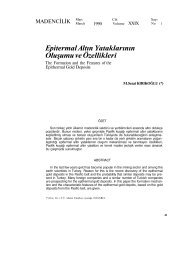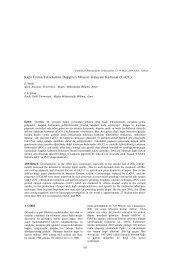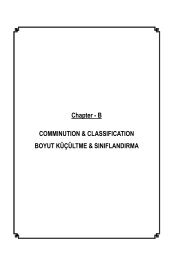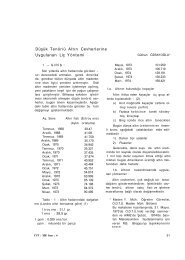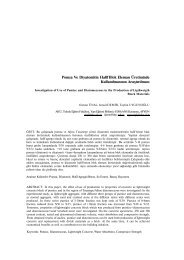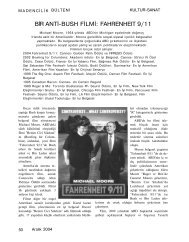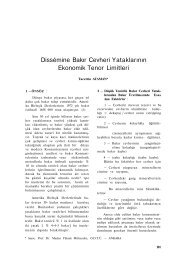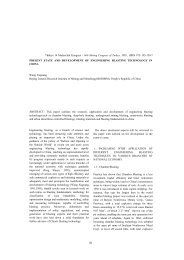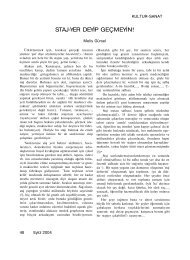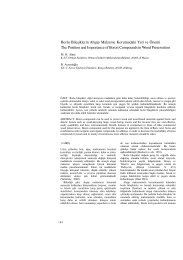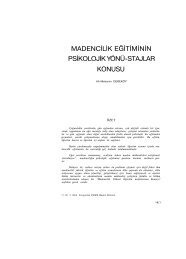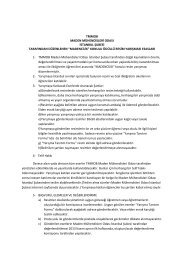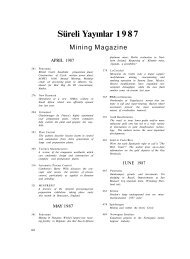A OPEN PIT MINING AÇIK OCAK MADENCİLİĞİ
A OPEN PIT MINING AÇIK OCAK MADENCİLİĞİ
A OPEN PIT MINING AÇIK OCAK MADENCİLİĞİ
You also want an ePaper? Increase the reach of your titles
YUMPU automatically turns print PDFs into web optimized ePapers that Google loves.
23 rd <br />
A Genetic Algorithm for Pit Limit and Blending Optimization<br />
M. Rahmanpour, M. Osanloo<br />
Amirkabir University of Technology (Tehran Polytechnic), Tehran, Iran<br />
ABSTRACT Pit limit is the set of those blocks that are profitable to be exploited by open pit<br />
mining methods. In traditional pit limit optimization techniques, one cannot take into account<br />
the requirements of blending. Some commodities such as iron ore, coal, limestone, and<br />
industrial minerals need to be blended to provide a product that suits consumer’s<br />
requirements. In this paper a combination of genetic and pit design algorithms is used to<br />
determine the pit limit of an open pit mine considering the blending requirements. The<br />
approach uses a self-adaptive differential evolution algorithm (jDE) to selects those blocks<br />
that meet the blend requirements, then modifies the block values, and determines the pit<br />
limits. The resulting pit is a set of those blocks that are profitable to be exploited and blended<br />
by open pit mining.<br />
1 INTRODUCTION<br />
Developing a ‘Geological block model’ is<br />
the first step in computerized mine planning.<br />
In order to construct the Geological block<br />
model of the deposit, the ore deposit or the<br />
orebody is divided into fixed size rectangular<br />
part which is called a ‘block’. The size of<br />
blocks depends on the exploration drilling<br />
pattern, orebody geology and the size of<br />
mining equipment. After determining the<br />
block dimensions, geological characteristics<br />
of each block are assigned using inverse<br />
distance, geostatistical methods, conditional<br />
simulation or other available techniques.<br />
This set of blocks which is based upon level<br />
of geological knowledge and confidence, is<br />
called a ‘Geological block model’. Then,<br />
using economic data (selling price, operating<br />
costs, recoveries, mining and processing<br />
costs), the economic value of each block or<br />
"Block Economic Value" (BEV) will be<br />
calculated. The block model containing the<br />
BEVs is called "Economic block model".<br />
The aim of mine planning is to determine<br />
whether a given set of blocks should be<br />
mined or not, if so, at which time it should be<br />
mined, and once it is mined, how it should<br />
then be processed, to maximize the net<br />
present value of the operation (Dagdelen,<br />
2007).<br />
Determining the final pit outline is the<br />
initial step of mine planning. It determines<br />
the set of blocks with the highest profit,<br />
which could be exploited by open pit mining.<br />
The solution to the final pit limits problem is<br />
usually used to justify the project<br />
economically and it is also a guide to the<br />
mine planner to locate the mine site facilities.<br />
There are many methods introduced by<br />
researchers to determine and optimize the<br />
ultimate pit limit (Newman et al. 2010).<br />
Before applying any of the pit limit<br />
optimization techniques, BEVs should be<br />
calculated through this formula:<br />
BEV = (metal content) × price × recovery<br />
(1)<br />
- processing costs - mining costs<br />
Equation 1 is true when it is applied to<br />
mineral such as gold, copper, and diamond.<br />
When it comes to mineral like iron ore, coal,<br />
119



